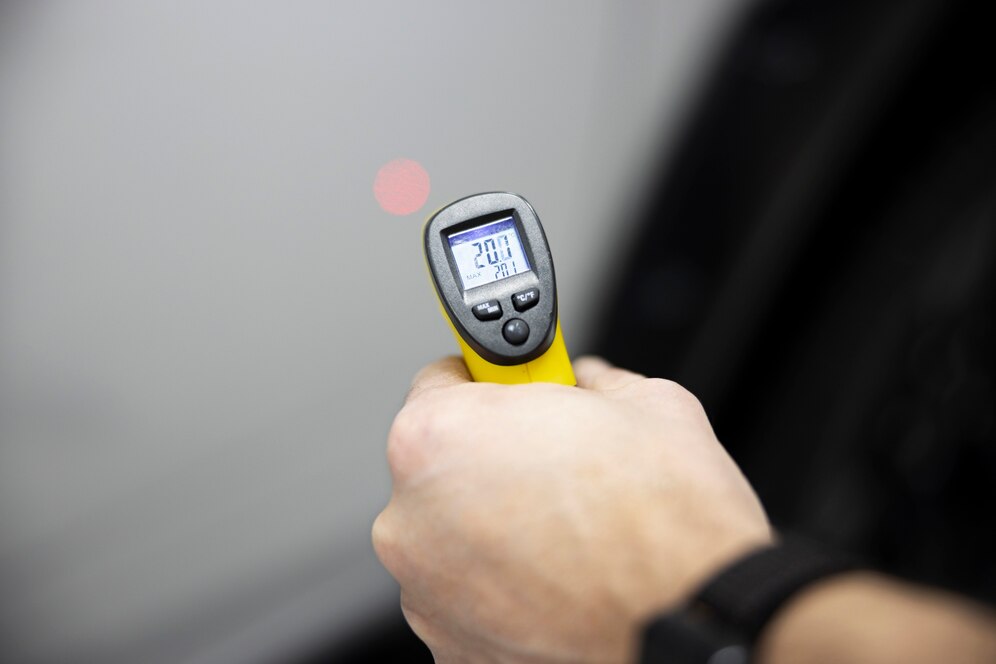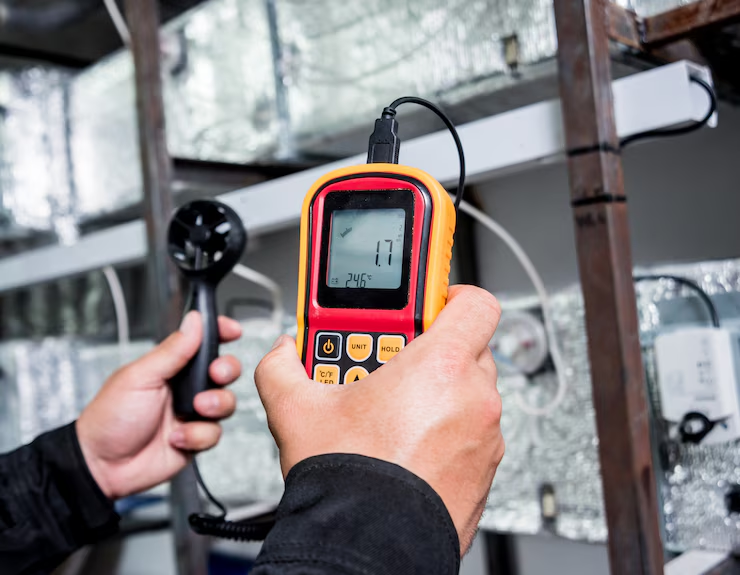Introduction
Measuring instruments like a moisture analyzer play a vital role in maintaining accuracy and quality in both laboratories and industrial setups. Whether you’re in pharmaceuticals, food production, agriculture, or chemical manufacturing, moisture content can significantly impact product integrity, shelf life, safety, and regulatory compliance. Even a small variation in moisture can lead to spoilage, loss of potency, or failed audits.
With rising quality standards in Ahmedabad, Gujarat, more businesses are relying on reliable measuring instruments for everyday operations. In this guide, we’ll explore how to use a moisture analyzer effectively, its industrial importance, usage tips, and common mistakes to avoid.

What Is a Moisture Analyzer?
A moisture analyzer is a high-precision measuring instrument used to determine the moisture content in samples by weighing them before and after drying. This process helps in maintaining quality and avoiding spoilage due to excess moisture, especially in sensitive products.
Key Components:
1.Heating Unit (Halogen or Infrared):
This unit quickly heats the sample to evaporate moisture content. Infrared heating offers consistent results and is energy-efficient. Halogen heating is ideal for rapid drying in labs that handle many samples daily.
2.Analytical Balance:
Ensures accurate weight measurement before and after drying. The balance must be sensitive to even the smallest weight changes, making it one of the most critical components in measuring instruments.
3. Digital Display & Control Panel:
Allows users to set drying parameters, view test progress, and analyze results in real-time. Modern analyzers come with touchscreen interfaces, data storage, and USB ports for easy report sharing.
Why Moisture Analysis Is Crucial in Labs and Industries
Understanding moisture content isn’t just about product quality—it’s about regulatory compliance, safety, and profitability. Precise moisture analyzers prevent issues that can lead to product recalls or reduced shelf life.
Benefits of Moisture Analysis:
- Prevents Spoilage in Food Products:
Moisture content in items like spices, grains, and snacks can lead to mold growth and early spoilage. Analyzers ensure safe moisture levels for longer shelf life and consumer safety. - Ensures Product Stability in Pharma:
In pharmaceutical production, even 1% moisture variation can compromise drug stability and effectiveness. Regular testing with a reliable measuring instrument helps meet stringent industry standards. - Reduces Material Waste:
Over-drying or under-drying materials can lead to unusable batches. Moisture analyzers help avoid rework, saving costs and reducing material wastage significantly. - Supports ISO and GMP Compliance:
Many industries, including cosmetics and chemicals, must comply with international standards. Using certified measuring instruments helps maintain documentation and validation protocols.
How to Use a Moisture Analyzer Effectively
To ensure reliable and repeatable results, it’s essential to use your moisture analyzer following the correct procedure.
Step-by-Step Usage Guide:
- Turn on the Analyzer:
Let it warm up for 10–15 minutes if needed. This ensures stability in the internal balance and consistent heating—important for precise moisture detection. - Tare the Balance with Empty Pan:
Always tare the pan to zero before adding the sample. This step ensures the reading reflects only the sample weight, eliminating errors in measurement. - Place the Sample Evenly:
Distribute the sample thinly and uniformly across the pan. Uneven spreading can lead to inaccurate readings due to irregular heating and drying. - Close the Lid and Set Drying Method:
Choose from standard, fast, or gentle drying based on sample type. For example, delicate materials may require lower temperatures to prevent degradation. - Initiate the Test and Monitor:
Once the drying process begins, monitor the display to view real-time changes in weight and moisture percentage. Most analyzers auto-end the test once weight stabilizes. - View Results and Save Data:
Modern moisture analyzers allow exporting data via USB or direct printing. Store the results for documentation and quality audits.




Common Mistakes to Avoid While Using Moisture Analyzers
Even skilled technicians can make errors that compromise test accuracy. Being aware of these common mistakes will help maximize the performance of your measuring instruments.
Top Mistakes:
- Skipping Warm-Up Time:
Analyzers need to stabilize before use. Failing to allow proper warm-up can result in balance drift and inconsistent results.. - Using Uncalibrated or Dirty Sample Pans:
Dust, residue, or leftover materials can interfere with weight readings. Always clean and recalibrate equipment regularly to maintain precision. - Not Following Standard Drying Temperatures:
Overheating can degrade the sample while underheating might leave residual moisture. Follow manufacturer-recommended settings for each material type. - Inconsistent Sample Size and Thickness:
Varying sample thickness leads to uneven heating and unreliable results. Standardizing sample weight and thickness improves accuracy and reproducibility.
Applications of Moisture Analyzers Across Industries
In Ahmedabad, Gujarat, several sectors rely on moisture analyzers to uphold product integrity and operational efficiency.
| Industry | Application | Example |
|---|---|---|
| Food | Moisture in grains, flour, spices | Ensures shelf life and prevents fungal growth |
| Pharma | Water content in tablets, powders | Maintains chemical stability and potency |
| Chemical | Solvent levels, resin content | Prevents contamination and improves safety |
| Agriculture | Seed moisture before storage | Reduces spoilage and supports better germination |
Conclusion
Moisture analyzers are critical measuring instruments that help industries across Ahmedabad and beyond meet stringent quality, safety, and compliance standards. By using them correctly and avoiding common mistakes, labs and factories can improve output quality, reduce costs, and comply with global regulations.
At Acro Enterprise, based in Ahmedabad, Gujarat, we offer a wide range of moisture analyzers and advanced measuring instruments designed to fit diverse industry needs.
👉 Explore our complete range of measuring instruments today to upgrade your quality control process. Visit Acro Enterprise
Need Expert Support to Take Your Business Further?
At Acro Enterprise, we specialize in helping businesses streamline operations and achieve sustainable growth through tailored solutions. Whether you’re just starting out or scaling up, our experts are here to guide you every step of the way.

